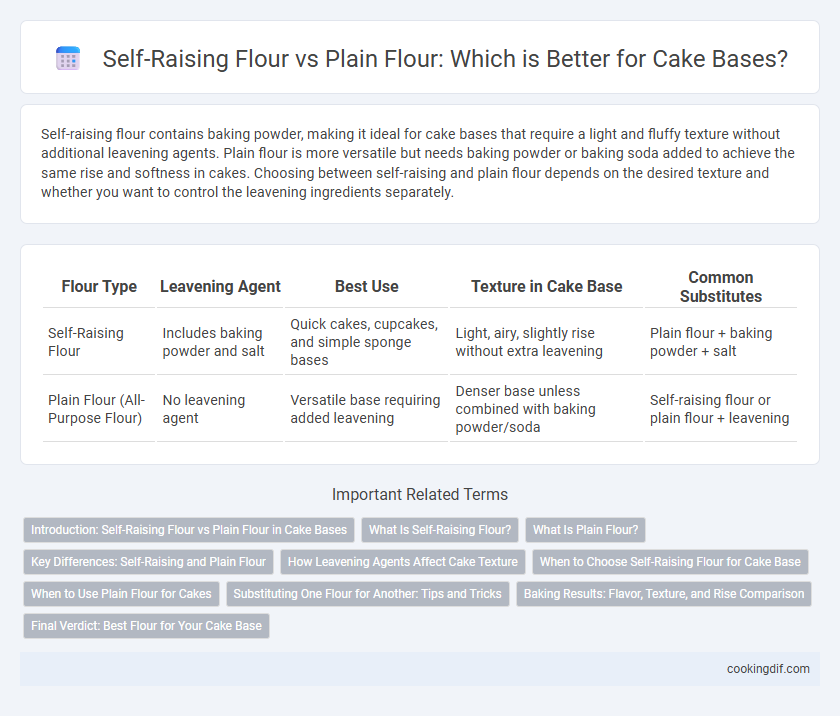Self-raising flour contains baking powder, making it ideal for cake bases that require a light and fluffy texture without additional leavening agents. Plain flour is more versatile but needs baking powder or baking soda added to achieve the same rise and softness in cakes. Choosing between self-raising and plain flour depends on the desired texture and whether you want to control the leavening ingredients separately.
Table of Comparison
| Flour Type | Leavening Agent | Best Use | Texture in Cake Base | Common Substitutes |
|---|---|---|---|---|
| Self-Raising Flour | Includes baking powder and salt | Quick cakes, cupcakes, and simple sponge bases | Light, airy, slightly rise without extra leavening | Plain flour + baking powder + salt |
| Plain Flour (All-Purpose Flour) | No leavening agent | Versatile base requiring added leavening | Denser base unless combined with baking powder/soda | Self-raising flour or plain flour + leavening |
Introduction: Self-Raising Flour vs Plain Flour in Cake Bases
Self-raising flour contains a pre-mixed blend of flour, baking powder, and salt, which helps the cake base rise without needing extra leavening agents. Plain flour, also known as all-purpose flour, requires the addition of baking powder or baking soda to achieve similar leavening effects. Choosing between self-raising and plain flour affects the texture, rise, and density of the cake base.
What Is Self-Raising Flour?
Self-raising flour is a pre-mixed combination of plain flour and a leavening agent, usually baking powder, designed to help cakes and other baked goods rise without the need for additional ingredients. It offers a consistent rise and lighter texture, making it ideal for sponge cakes and quick breads where a tender crumb is desired. Unlike plain flour, which requires separate leavening agents, self-raising flour simplifies the baking process and ensures evenly distributed leavening for optimal results.
What Is Plain Flour?
Plain flour, also known as all-purpose flour, is a versatile baking ingredient made from milled wheat without added raising agents. It provides a neutral base for cakes, allowing bakers to control texture and rise by adding specific leavening agents like baking powder or baking soda. This flour type is essential for recipes requiring precise texture adjustments, as it does not influence the cake's rise on its own.
Key Differences: Self-Raising and Plain Flour
Self-raising flour contains baking powder and salt, making it ideal for cakes that require leavening without additional ingredients. Plain flour, also known as all-purpose flour, lacks these additives and requires separate leavening agents like baking powder or soda for the cake to rise. Using self-raising flour simplifies recipes by combining flour and raising agents, while plain flour offers more control over texture and rise in baking.
How Leavening Agents Affect Cake Texture
Self-raising flour contains baking powder, a leavening agent that produces carbon dioxide bubbles during baking, resulting in a lighter and airier cake texture. Plain flour lacks these agents, requiring manual addition of baking powder or baking soda to achieve similar rise and softness. The choice between self-raising and plain flour directly influences crumb structure, moisture retention, and overall cake tenderness.
When to Choose Self-Raising Flour for Cake Base
Self-raising flour is ideal for cake bases when a light, airy texture is desired without adding separate leavening agents. It contains a balanced blend of flour, baking powder, and salt, which helps achieve consistent rising and a soft crumb in sponge and chiffon cakes. Use self-raising flour for recipes that rely on chemical leavening rather than eggs or mechanical aeration for rise.
When to Use Plain Flour for Cakes
Plain flour is ideal for dense or rich cakes like fruitcakes or brownies, where minimal rise is desired. It provides a consistent texture without the added leavening agents found in self-raising flour. Use plain flour when the recipe includes specific rising agents such as baking powder or baking soda to control the cake's rise and structure.
Substituting One Flour for Another: Tips and Tricks
When substituting self-raising flour for plain flour in a cake base, reduce or omit baking powder to maintain proper rise and texture. Use a 1:1 ratio but adjust leavening agents accordingly, as self-raising flour contains baking powder and salt. For plain flour substitutions, add 1.5 teaspoons of baking powder and 1/4 teaspoon of salt per cup to mimic self-raising flour's leavening properties.
Baking Results: Flavor, Texture, and Rise Comparison
Self-raising flour contains baking powder and salt, producing a lighter cake with a tender crumb and a slight tang in flavor, ideal for quick bakes. Plain flour lacks leavening agents, resulting in denser texture and a more neutral taste, requiring additional baking powder to achieve rise. Using self-raising flour ensures consistent height and softness, while plain flour offers control over flavor and texture customization through added ingredients.
Final Verdict: Best Flour for Your Cake Base
Self-raising flour contains baking powder and salt, making it ideal for quick, fluffy cake bases without extra leavening agents, while plain flour requires added baking soda or powder to achieve similar rise and texture. Choosing self-raising flour ensures consistent results and saves preparation time, especially for simple or beginner-friendly recipes. For more control over flavor and density, plain flour with custom leavening allows bakers to tailor the cake base precisely to their desired outcome.
Self-raising flour vs Plain flour for base Infographic

 cookingdif.com
cookingdif.com